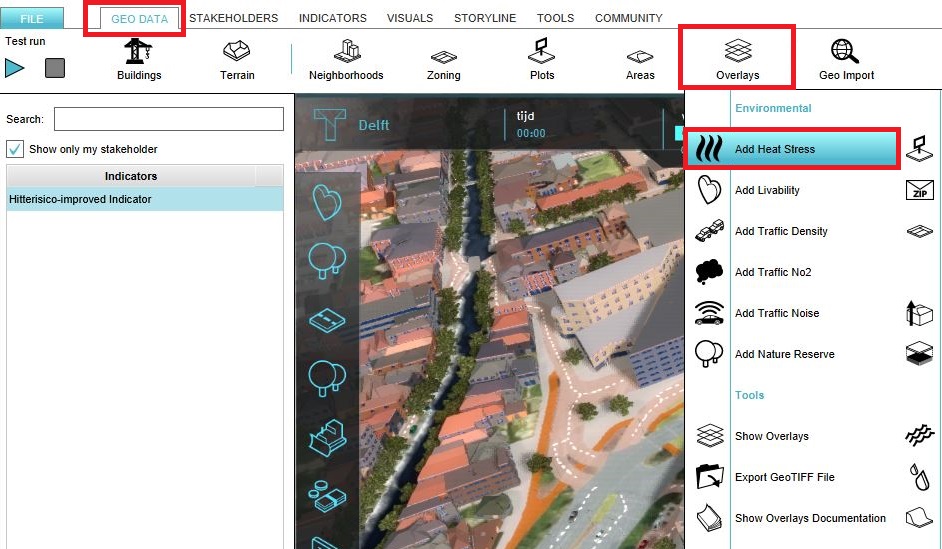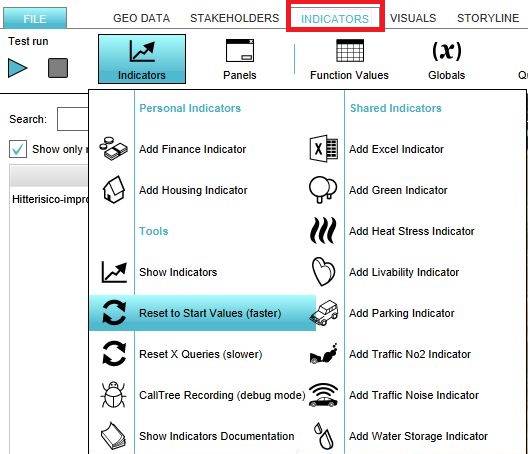Heat risk (Indicator): Difference between revisions
No edit summary |
|||
| Line 31: | Line 31: | ||
When the indicator is added to the project, an error message is given. To solve this, the heat stress overlay has to be added. | When the indicator is added to the project, an error message is given. To solve this, the heat stress overlay has to be added. | ||
{{Editor steps|title=add the Heat stress overlay|Select in the editor 'Geo Data' from the ribbon|Select 'Overlays' from the ribbon bar|Select the Heat stress overlay from the drop down menu|Click on the tab Indicators and the button Indicators and choose for Reset to Start values (faster) to update your project.}} | {{Editor steps|title=add the Heat stress overlay|Select in the editor 'Geo Data' from the ribbon|Select 'Overlays' from the ribbon bar|Select the Heat stress overlay from the drop down menu|Click on the tab Indicators and the button Indicators and choose for Reset to Start values (faster) to update your project.}} | ||
<br clear=all> | |||
[[File:Reset.JPG|400px|left]] | [[File:Reset.JPG|400px|left]] | ||
Revision as of 11:10, 27 February 2019
General
What is the Heat risk indicator?
The heat risk indicator calculates a metric for the risk to vulnerable citizens due to heat stress. It correlates information on residents over 65 years old from CBS data which is a Dutch dataset, the Heat stress Overlay and the amount of new build houses. In this indicator it is assumed that new build houses have better isolation and therefore facilitates better heat retention. The building year from houses is known from the BAG dataset which is used in created a project in the Netherlands.. This indicator is for example useful for projects in where:
- heat stress and the effct on citizens is measured
- livability is an important goal
Indicator panel

The indicator panel (see the image on the right) shows in a table per neighborhood:
- the neighborhood name
- the average heat stress
- the amount of elderly people (65 years and older) and the total amount of people living in this neighborhood
- the amount of elderly people that are living in new build houses
- the risk assigned to this neighborhood. The highter the number, the higher the heat risk is.
Calculation
First the heat stress in an area is calculated. For more information about this calculation, read the following Section. Then the amount of people older than 65 years are counted for each neighborhood.The amount of houses after 2012 are counted as new build houses. The risk is then calculated as: risk = Percentage elderly people x the heat stress in degrees.
Score
The score is represented in a progress bar, with a scale from 0 to 100%.
Additional configurations
For this indicator to function, only the heat stress overlay has to be added to the project, see below for the steps. However, due to the reliance on CBS data which is a dataset for the Netherlands, the indicator will only function on projects located in the Netherlands.
add the Heat stress overlay

When the indicator is added to the project, an error message is given. To solve this, the heat stress overlay has to be added.
- Select in the editor 'Geo Data' from the ribbon
- Select 'Overlays' from the ribbon bar
- Select the Heat stress overlay from the drop down menu
- Click on the tab Indicators and the button Indicators and choose for Reset to Start values (faster) to update your project.
